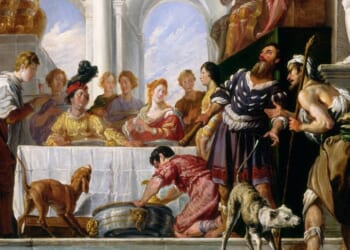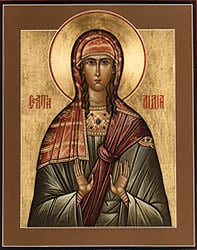“I like you better without your beretta,” said James Bond to his love interest after meeting her for the second time. Had she been wearing some sort of French hat when they first met? No, she had been wearing a gun. James Bond had spied the woman’s Beretta handgun under her dress. At their second meeting, the unarmed, Beretta-less woman had to admit, “I feel naked without it.”
Do you like me better without my biretta? I’m referring here not to a handgun, but to the funny-looking hat I wear as I process into Mass. It’s called a biretta, from the Latin birrus meaning “cloak with a hood.”
A few years back someone wrote a good article on the biretta. The writer began by explaining that in the Roman Empire slaves were commanded to shave their heads to differentiate themselves from their masters. In doing so, slaves would seek the services of the tonsor, which is Latin for “barber.” In the late 7th century, Roman Catholic clergy took up this symbol of slavery. Upon receiving the sacrament of Holy Orders, priests’ heads were shaved, which was called receiving their tonsure.
The introduction of tonsure led to the introduction of the clerical cap. As people with shaved or bald heads can tell you, heat leaves unprotected heads quite quickly, so priests started wearing hats. At first the hats had flat, square tops, akin to graduation caps. This makes sense because priests were the professors at universities. But over time the clerical hat became raised, featuring three seams (blades) that made the hat easy to put on and take off.
Clerical head coverings are actually found near the beginning of the Bible. In the Book of Exodus, at the ordination of the first high priest, Aaron, God instructed Moses to put a tall hat, called a turban or a miter on Aaron’s head, “and Aaron shall take upon himself any guilt incurred in the holy offering” (Ex. 28:36-38).
The Jewish Talmud (Zevachim 88b:6), which is the tradition of the Pharisees, states that the turban or miter worn by the Jewish high priest “atones for the arrogant.” Rabbis wrote, “It is logical that an item that is placed at an elevation, i.e., on the head of a priest, shall come and atone for the sin of an elevated heart.” So, the clerical head covering atones for arrogance. Thus, when a Catholic priest wears the biretta (which he did much more frequently until the 1970s), the priest should recall his sins of conceit. The writer put this way:
Children never cease to poke fun at the biretta. It does not frame the face, it is tall, asymmetrical, and has a large pompom on top of it. One does not don the biretta and walk out of the sacristy thinking, “handsome.” For the priest, it adds an element of humility. He may be ridiculed for it; but he endures it for the sake of Christ.
Further in Exodus 28, Aaron is told to make headdresses for his sons, for beauty and glory. In the case of the biretta, the beauty and glory are God’s and not the one who wears it. In a time where clergy are wearing skinny jeans and designer clothes to look fashionable and draw attention to themselves, or at least their physique or taste, the biretta does the opposite.
Some say the main reason one wears the biretta is so he can take it off, the writer points out, which “sounds nonsensical. One wears a hat to wear the hat. In the case of the biretta, however, part of its purpose is to call attention to when it is not worn.” For example, it is not worn near or at the altar, nor during processions of the Blessed Sacrament, and it is removed whenever the Holy Name of Jesus is uttered.
This, perhaps, is the most significant part of wearing the biretta—taking it off at the Holy Name. Over time, bowing the head at the name of Jesus became an involuntary devotion. Removing the biretta at the Holy Name is a reminder for all to bow their heads. When this is done regularly, two things will emerge: the people will pay more attention to the readings and sermon and they will develop a devotion to the Holy Name. They will hear differently Philippians 2.9-11:
“Therefore, God also highly exalted Him and gave Him the name that is above every name, so that at the name of Jesus every knee should bend, in heaven and on earth and under the earth, and every tongue should confess that Jesus Christ is Lord to the glory of God the Father.”
The author stated how we have become too casual with names. In doing so we presume an intimacy with others that really should not be there. It is this same type of casualness that would have people presume with God. They presume on His mercy, which can never be a good thing.
The Holy Name was given to us to revere and respect as the Name of our Salvation; it is the Name of our hope. It is not an expletive. Removing the biretta at the Holy Name promotes a certain kind of Christian chivalry.
Of course, lost modern types hear the word “chivalry” and cry out, “medieval,” “rigid,” and “backwards!” But as the author noted, there is great virtue to be found here. Doffing the biretta promotes discipline of the tongue and reverence in speech. It also instills in us an automatic response to the Holy Name. “In all the words that we have chosen to use for God and for each other, surely this is a good thing. The biretta, simply by itself, is a protest against vulgarity.” The author continues:
The biretta is a statement. It reminds the priest that, even if the tonsure has been abolished, he is a joyful slave to Jesus Christ. It is a statement of humility, to purposefully wear something that looks so strange. It is a statement of reverence in an age of license and ugliness.
My friends, Jesus Christ is the most beautiful person in the world. And He did the most beautiful thing by laying down His life so we may live. This divine act is made mystically present at the Holy Sacrifice of Mass. That is why Holy Mass should look like the most beautiful thing in the world—because that is what it is.
The casualness, license, and downright ugliness injected into Holy Mass in our own time has brought with it presumption of God’s mercy—something Christ warned against: “Gird your loins and light your lamps and be like servants who await their master’s return from a wedding, ready to open immediately when he comes and knocks.” That means you are to get in the state of grace and stay there, for blessed are those servants whom the master finds vigilant on His arrival.
Amen, I say to you, He will gird Himself, have them recline at table, and proceed to wait on them.
How beautiful is that? The altar rail is the table where you recline, and Christ Himself proceeds to wait on you, feeding you His Body and Blood. But before that can happen, Christ, the true High Priest, takes upon Himself our guilt incurred in the holy offering. At Mass you, via your sins, put a funny-looking hat on your High Priest, a tall crown of thorns on His head, before He makes His way to Calvary. Scholars argue the crown of thorns looked less like a wreath and more like a tall head covering, something more akin to a dunce cap; something children on the streets of Jerusalem would have poked fun at.
Now, I as a ministerial priest must configure myself to Christ, the one True Priest. I, like Christ, must be both priest and victim of the sacrifice. I then must take upon myself guilt incurred in the holy offering. That is why there is a cross on the back of my vestment. And that is why there is a funny-looking hat on my head. It is there to atone for arrogance, conceit, and an elevated heart. It is there for the beauty and glory of God.
And that my friends, is why I wear the biretta. I feel naked without it.
Image from Wikimedia Commons
















